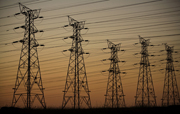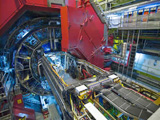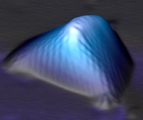


The Lab has decided to enter another area of battery research, using a $1.6 million in American Recovery and Reinvestment Act funds to develop a novel storage device for the electric grid. Grid-scale storage would allow grid operators to use more renewable energy, such as wind and solar, which are known as “variable loads” because they are inconstant. A grid-scale battery could collect all the energy generated when, say, the wind blows during sunrise and sunset and then discharge during the rest of the day, allowing the grid to distribute the energy when demand is higher. More>
 The fourth of five Carbon Smackdown matches takes place Tuesday at noon in the Building 50 Auditorium. Grab your lunch and learn how Berkeley Lab scientists are developing energy-saving smart windows using the latest tricks in nanotechnology. Delia Milliron of the Materials Sciences Division and Stephen Selkowitz of the Environmental Energy Technologies Division will also answer your questions. Can’t leave your desk at noon? We’ve got you covered with a live webcast. You can also go there to watch the three previous Smackdown lectures. Check out the complete line-up of matches pitting Berkeley Lab scientists against carbon dioxide.
The fourth of five Carbon Smackdown matches takes place Tuesday at noon in the Building 50 Auditorium. Grab your lunch and learn how Berkeley Lab scientists are developing energy-saving smart windows using the latest tricks in nanotechnology. Delia Milliron of the Materials Sciences Division and Stephen Selkowitz of the Environmental Energy Technologies Division will also answer your questions. Can’t leave your desk at noon? We’ve got you covered with a live webcast. You can also go there to watch the three previous Smackdown lectures. Check out the complete line-up of matches pitting Berkeley Lab scientists against carbon dioxide.
 One month a year, the nuclei of lead atoms traveling near the speed of light will collide in the Large Hadron Collider’s (LHC) ALICE experiment. Ten percent of all of the data collected in this month will travel from Switzerland to NERSC at the Berkeley and Livermore Labs via the Energy Sciences Network (ESnet). These facilities will provide the primary computing and storage resources for the ALICE collaboration in North and South America. More>
One month a year, the nuclei of lead atoms traveling near the speed of light will collide in the Large Hadron Collider’s (LHC) ALICE experiment. Ten percent of all of the data collected in this month will travel from Switzerland to NERSC at the Berkeley and Livermore Labs via the Energy Sciences Network (ESnet). These facilities will provide the primary computing and storage resources for the ALICE collaboration in North and South America. More>
 Research: Graphene Under Strain Creates Psuedo-Magnetic Fields
Research: Graphene Under Strain Creates Psuedo-Magnetic Fields In the current issue of the journal Science, a multi-institutional team of researchers headed by Berkeley Lab’s Michael Crommie, of the Materials Sciences Division, reports the creation of pseudo-magnetic fields far stronger than the strongest magnetic fields ever sustained in a laboratory – just by putting the right kind of strain onto a patch of graphene. This discovery opens a new window on a source of important applications and fundamental scientific discoveries going back over a century. More>
 Two near-miss accidents underscore the need for vehicle drivers to stop and wait for shuttle bus passengers to board and get off the bus, and unload their bicycles, before proceeding. The first incident occurred at the blue route bus stop near the cafeteria. A pedestrian who was unloading his bicycle was nearly struck by a car that went around the bus and illegally crossed the double yellow line. The second incident occurred at the Firehouse. Passengers were attempting to cross the road in front of the bus when they were nearly struck by a car attempting to pass the stopped bus by crossing the double yellow line. Lab employees are reminded that, according to the California vehicle code, it is illegal to cross the double yellow line. Doing so puts others at risk.
Two near-miss accidents underscore the need for vehicle drivers to stop and wait for shuttle bus passengers to board and get off the bus, and unload their bicycles, before proceeding. The first incident occurred at the blue route bus stop near the cafeteria. A pedestrian who was unloading his bicycle was nearly struck by a car that went around the bus and illegally crossed the double yellow line. The second incident occurred at the Firehouse. Passengers were attempting to cross the road in front of the bus when they were nearly struck by a car attempting to pass the stopped bus by crossing the double yellow line. Lab employees are reminded that, according to the California vehicle code, it is illegal to cross the double yellow line. Doing so puts others at risk.
Today
at Berkeley Lab encourages feedback and story ideas
Deadline for submissions is 10 a.m. two days prior to publication
TABL is produced by Public Affairs' Communications Group